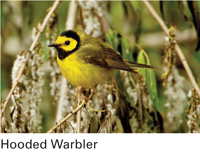What to Look for in the Park – Spring Migration

 Spring is a fabulous time to visit Cullinan Park to enjoy mild weather and blooming plant life. For birders, it is the most eagerly anticipated time of year. Spring migration is the annual pilgrimage many birds make from their winter homes in Central and South America to their breeding grounds in the U.S. and Canada. After crossing the Gulf of Mexico, these Northbound neotropical migrants stop along the Texas coast to rest and feed before continuing on: flycatchers, vireos, thrushes, warblers, tanagers, orioles, and more. The action starts in March and peaks in late April and early May.
Spring is a fabulous time to visit Cullinan Park to enjoy mild weather and blooming plant life. For birders, it is the most eagerly anticipated time of year. Spring migration is the annual pilgrimage many birds make from their winter homes in Central and South America to their breeding grounds in the U.S. and Canada. After crossing the Gulf of Mexico, these Northbound neotropical migrants stop along the Texas coast to rest and feed before continuing on: flycatchers, vireos, thrushes, warblers, tanagers, orioles, and more. The action starts in March and peaks in late April and early May.

 Cullinan Park is one of the best places in Fort Bend to see colorful wood-warblers and other migrants, especially when the wind conditions cause birds to stop a bit further inland from the coast. Last year on May 11, the first Texas Birding Classic Big Sit held at the park yielded 41 species in just a few hours. All the birds had to be spotted from a 17-foot circle in the observation tower. Some of the migrants logged were: Olive-Sided Flycatcher, Red-Eyed Vireo, Purple Martin, Marsh Wren, Swainson’s Thrush, Tennessee Warbler. Yellow Warbler, Chestnut-Sided Warbler and Rose-Breasted Grosbeak. At least 31 species of warblers have been recorded at Cullinan, and it’s not uncommon for birders to find more than 50 bird species on a good day during migration. A pair of binoculars is helpful for spotting the tiny feathered travelers as they flit around in the trees, refueling for the remainder of their journey.
Cullinan Park is one of the best places in Fort Bend to see colorful wood-warblers and other migrants, especially when the wind conditions cause birds to stop a bit further inland from the coast. Last year on May 11, the first Texas Birding Classic Big Sit held at the park yielded 41 species in just a few hours. All the birds had to be spotted from a 17-foot circle in the observation tower. Some of the migrants logged were: Olive-Sided Flycatcher, Red-Eyed Vireo, Purple Martin, Marsh Wren, Swainson’s Thrush, Tennessee Warbler. Yellow Warbler, Chestnut-Sided Warbler and Rose-Breasted Grosbeak. At least 31 species of warblers have been recorded at Cullinan, and it’s not uncommon for birders to find more than 50 bird species on a good day during migration. A pair of binoculars is helpful for spotting the tiny feathered travelers as they flit around in the trees, refueling for the remainder of their journey.
 Whether you want to watch the birds, hike the trails, catch a fish or just enjoy a picnic in the great outdoors, don’t miss Spring at the park.
Whether you want to watch the birds, hike the trails, catch a fish or just enjoy a picnic in the great outdoors, don’t miss Spring at the park.
